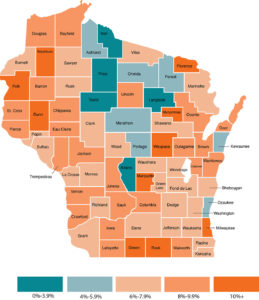Residential Property Values Soar

Much has been written about the housing boom over the past year. Homes are selling shortly after coming on the market often for well above asking price. New property value data from the Wisconsin Department of Revenue (DOR) confirm and quantify 2020’s real estate boom.
Statewide, the estimated value of all residential property rose 7.9% in 2020, up from an average growth of 4.7% over the preceding five years. In 10 counties, residential values rose more than 10%. In Adams, Iron, Langlade, Price, and Taylor counties, residential gains were more subdued at less than 4%.
The figures come from a detailed dataset on equalized values, which are aggregated property value estimates that are used by local units of government to set property tax rates. DOR releases preliminary figures in early August to allow local governments to review for errors. With a rare exception, the preliminary figures match the final numbers released on August 15th. The latest numbers reflect housing activity during 2020.
There was no discernible pattern to the property value increases. Counties with gains above 10% included urban Milwaukee and Rock counties, along with less populous rural counties such as Florence, Marquette, and Menominee (see map).
For homeowners, rising values can be both good and bad news. On the bright side, the new DOR figures indicate that home values are rising significantly, making homeowners wealthier.
Rising home values can also negatively impact residents in a few ways. First, rising home values can lead to increased property taxes due to a shifting of the property tax burden. The various property tax limits in Wisconsin create a system in which total property tax levies don’t necessarily rise or fall with property values. However, when one class of property – for example, residential – increases faster than other types, the tax burden shifts.
While residential property rose 7.9% in value, all other taxable property (commercial, manufacturing, etc.) combined increased 4.3%. This led to the rise in the residential share of the property tax burden to 71.5% this year from 70.8% last year. Even if all property tax levies remain unchanged this year, the average homeowner would see a 1% property tax increase. Owners of other property would see a 2.5% decrease.
Second, rising home values can act as a barrier to potential first-time homeowners. While increased value is good for current homeowners, local communities thrive when new residents move in. Higher prices can block young families from relocating to a community. A recent report from the National Association of Realtors indicated that 82% of buyers aged 22 to 30 and 48% of buyers aged 31 to 40 were first time buyers.
